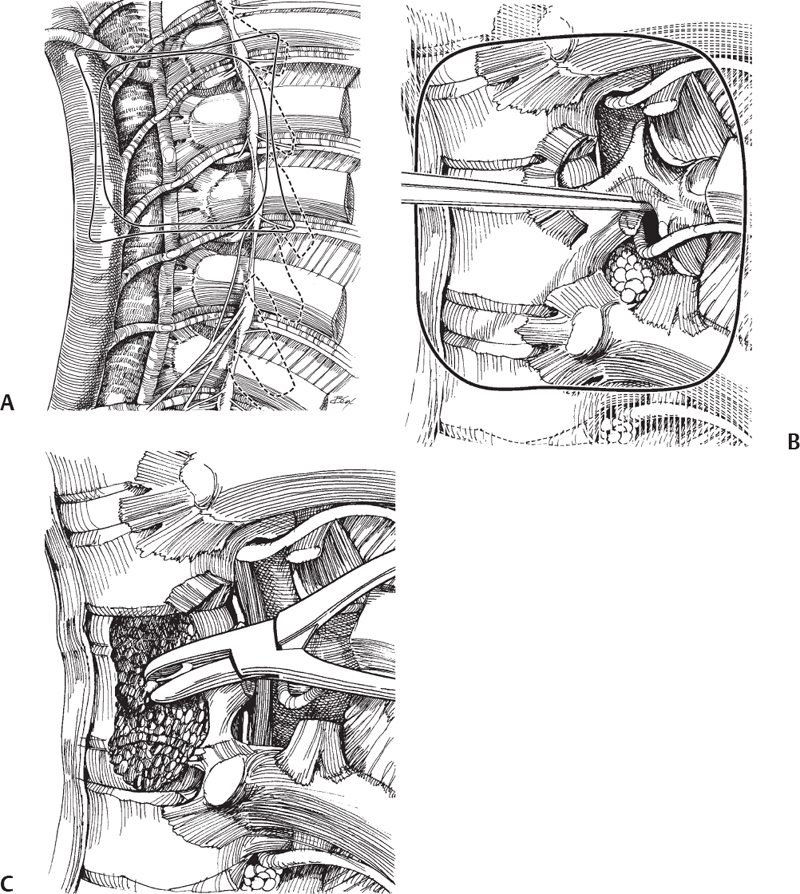47 Transthoracic Approach
I. Key Points
– The transthoracic approach places the major vessels of the thoracic cavity at risk and threatens injury to the lungs and heart.
– An injury to the spinal cord at this level may result in paraplegia.
– Mark levels carefully, and make frequent use of radiographs or fluoroscopy.
II. Indications
– Thoracic myelopathy resulting from spinal cord compression1
• Herniated nucleus pulposus (HNP), stenosis, or ossification of the posterior longitudinal ligament (OPLL)
• Cervical and lumbar pathology ruled out
– Infections
• Discitis or osteomyelitis
– Trauma
– Tumors
– Not for axial thoracic spine pain
III. Technique
– Position lateral decubitus.2
– Alert anesthesia staff to use double-lumen endotracheal tube so that deflation of lung can be performed if necessary.
– Confirm level(s)
• If using open technique, manually palpate ribs (enlist help of thoracic surgeon).
• Live fluoroscopy: use fixed markers, such as spinal needles placed into facet joints (to mark pedicles or ribs).
• Count ribs on anteroposterior (AP) view (take note of males with missing twelfth rib).
• Lower thoracic vertebrae can be counted from sacrum.
• Confirm as many times as necessary (thoracic vertebrae look alike!).
– Make skin incision over disc or vertebral body based on imaging.
• Semilinear or linear
– Upper thoracic discs (T2 to T5) may require mobilization of scapula.
• Cut latissimus dorsi, serratus anterior, and teres major muscles midsubstance—allows scapula to be deflected cephalad and dorsally.
– For lower thoracic discs (T9 to T12), hemidiaphragm may need to be released from the vertebrae.
– Resect rib for visualization (Fig. 47.1A–C).
• Preserve nerve root if possible; otherwise sacrifice by ligating a segment of nerve to prevent painful neuromas. Tell patient about post-op paresthesia.
• Excellent source of structural or morselized autograft
– Can get to discs and vertebrae via transpleural or retropleural approach
• Incise parietal pleura.
• Lifts off lateral side of vertebral body
– Deflate lung.
– Ligate segmental vessels close to azygous vein/aorta.
• Necessary for corpectomies
– Follow nerve root into foramen.
– Rib head resection is necessary above T9-T10.3
• May not be necessary at T11 or T12
• Helpful to see pedicle, the primary landmark for performing discectomy

Fig. 47.1 (A,B) A window is made through the parietal pleura over the vertebral body. (C) The corpectomy is performed all the way to the contralateral pedicle. (From Anterior thoracic decompression. In: Spine Surgery: Tricks of the Trade 2nd ed. Vaccarro AR, Albert TJ, eds. Thieme; pg. 108, Figs. 31.2, 31.3.)
IV. Complications
– Spinal cord injury
• Spinal neuromonitoring necessary
• Direct spinal cord trauma
• Vascular insufficiency
 Note ligation of multiple segmental vessels for multilevel surgery.
Note ligation of multiple segmental vessels for multilevel surgery.
– Lung injury
• From retractors, burr, other equpment
– Vascular injury
– Thoracic duct injury
• On the right in lower thoracic spine (T9 to T12), on the left in upper thoracic spine (T4 and above)
– Pneumothorax
– Post-op neuritis
V. Postoperative Care
– Chest tube, for transpleural approach
• Placed outside operative incision
– Bracing optional
VI. Outcomes
– Generally good for neurologic outcomes depending on the severity of preoperative myelopathy
• Can use Japanese Orthopedic Association score or Nurick grade
– Pain outcomes less predictable
VII. Surgical Pearls
– Mark levels carefully with good intra-op imaging.
– Can follow rib, rib head, and nerve root to disc space
Common Clinical Questions
1. Which of the following is not an appropriate indication for transthoracic spine surgery?
A. Infection
B. Tumor
C. Trauma
D. Back pain
2. Complications of transthoracic spine surgery include (choose all that apply):
A. Spinal cord injury
B. Incisional hernia
C. Neuralgia
D. Chylothorax
3. True or false: Thoracic vertebrae can be easily differentiated from one another.
Stay updated, free articles. Join our Telegram channel

Full access? Get Clinical Tree







